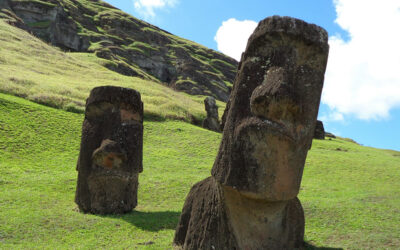While cracking nuts, long-tailed macaques make stone flakes that mirror those thought to be made purposefully by the earliest humans in East Africa. These similarities muddy the waters of the stone archaeological record and call for new measures to categorize stone flakes and tools made by early humans called hominins.
“The findings of this study challenge the traditional understanding of early hominin behavior and cognition by suggesting that some of the earliest evidence for technology may not have been intentionally produced by our ancestors,” said the authors in an email to ASN.
“Our findings suggest that unintentional flake production may have been more common than previously thought and highlights the importance of careful analysis when interpreting early lithic assemblages.”
Monkeys unintentionally produce similar stone flakes
Lydia Luncz, a researcher at the Max Planck Institute for Evolutionary Anthropology in Germany, and her collaborators were studying the intentional making of stone tools among past hominins. To understand the process, the researchers turned to living non-hominin primates that use stone tools, such as long-tailed macaques, who use them to crack open the hard exteriors of nuts and shellfish.
In the process, pieces of stone fracture off from the monkeys’ hammer stones and anvils, and can be spread far and wide. Luncz and her colleagues, which includes Tomos Proffitt of the Max Planck Institute for Evolutionary Anthropology, compared the stone flakes produced in this way to those that make up the collection of stone artifacts by early humans.
The team collected stone flakes made accidentally by macaques at Phang Nga National Park in Thailand. They compared this assortment of flakes with a collection of man-made stone artifacts dating from 3.3 to 1.56 million years ago taken from Tanzania, Ethiopia, and Kenya.
Their analyses revealed that in shape and structure, stone flakes produced by macaques in the process of cracking nuts closely resembled those made deliberately by the earliest humans. Due to this overlap, monkey-made stone artificants may inadvertently be considered anthropogenic.
“The degree of overlap between unintentional macaque flakes and intentional hominin flakes was astonishing,” said the researchers. “This suggests that unintentional flake production may have been more common than previously thought and highlights the importance of careful analysis when interpreting early lithic assemblages.”
Challenging origins
These findings expand the diversity of behaviors that are linked with stone artifacts left behind by the earliest humans. Moreover, the emergence of stone tools among hominins may have begun through nut cracking, an avenue that significantly turns back the archaeological clock. However, the authors cautioned that their findings were limited to a geographical area in Africa and nut-cracking alone, with no other activities analyzed.
Stone artifacts made by macaques and hominins appear to be similar in various ways, and distinguishing them on the basis of nothing but those features is inadequate. One way in which the flakes are similar is in the number of scars and the direction of scarring left behind on the surfaces of stones. But small differences between the two types of stone flakes do exist. For instance, flakes made by cracking nuts are likely to be thicker than those made by early humans.
“To improve our understanding of stone tool production in hominins, future research could focus on developing new analytical criteria that can better distinguish between intentional and unintentional flake production,” wrote the team.
“Additionally, comparative analyses between non-human primate material and early hominin lithic assemblages could be expanded to include a wider range of primate species and geographic regions to better understand the cognitive and behavioral processes that led to the development of technology in our lineage,” they continued.
In this way, living primates could provide some insight into the stone artifacts of hominins.
Reference: Tomos Proffitt, et al., Wild macaques challenge the origin of intentional tool production, Science Advances (2023). DOI: 10.1126/sciadv.ade8159
Feature image: Erik-Jan Leusink on Unsplash

















